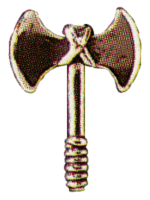|
Lambda & Labrys |

The lowercase Greek letter, lambda, carries several meanings. First of all, it represents scales, and thus balance. The Greeks considered balance to be the constant adjustment necessary to keep opposing forces from overcoming each other. The hook at the bottom of the right leg of the lambda represents the action required to reach and maintain balance. To the Spartans, the lambda meant unity. They felt that society should never infringe on anyone's individuality and freedom. The Romans adopted the letter to represent "the light of knowledge shed into the darkness of ignorance." Finally, in physics the symbol designates an energy exchange. Thus the lambda, with all its meanings, is an especially apt symbol for the gay liberation movement, which energetically seeks a balance in society and which strives through enlightenment to secure equal rights for homosexual people.
-Joseph P. Goodwin, "More Man Than You'll Ever Be: Gay
Folklore and Acculturation in Middle America"
(Indianapolis: Indiana University Press, 1989) p. 26

The labrys is a double-sided hatchet or axe commonly used in ancient European, African, and Asian matriarchal societies as both a weapon and a harvesting tool. Greek artwork depicts the amazon armies of Europe wielding labrys weapons. Amazons ruled with a dual-queen system in which one queen was in charge of the army and battle, and the other queen stayed behind to administer the conquered cities. Amazons were known to be ferocious and merciless in battle, but once victorious they ruled with justice. Today, the labrys is a lesbian and feminist symbol of strength and self-sufficiency.
In addition, the labrys also played a part in ancient mythology. Demeter, the goddess of the earth, used a labrys as her scepter. Rites associated with the worship of the Demeter, as well as Hecate (the goddess of the underworld), are believed to have involved lesbian sex.